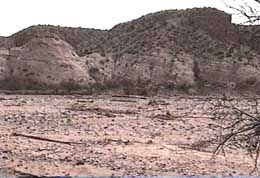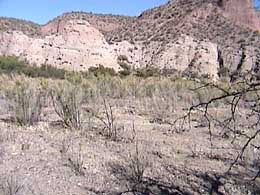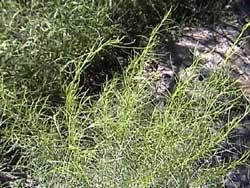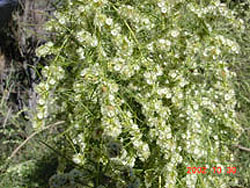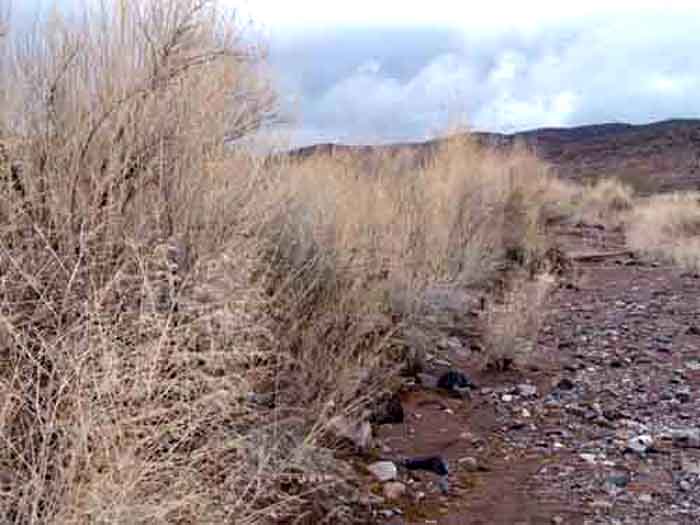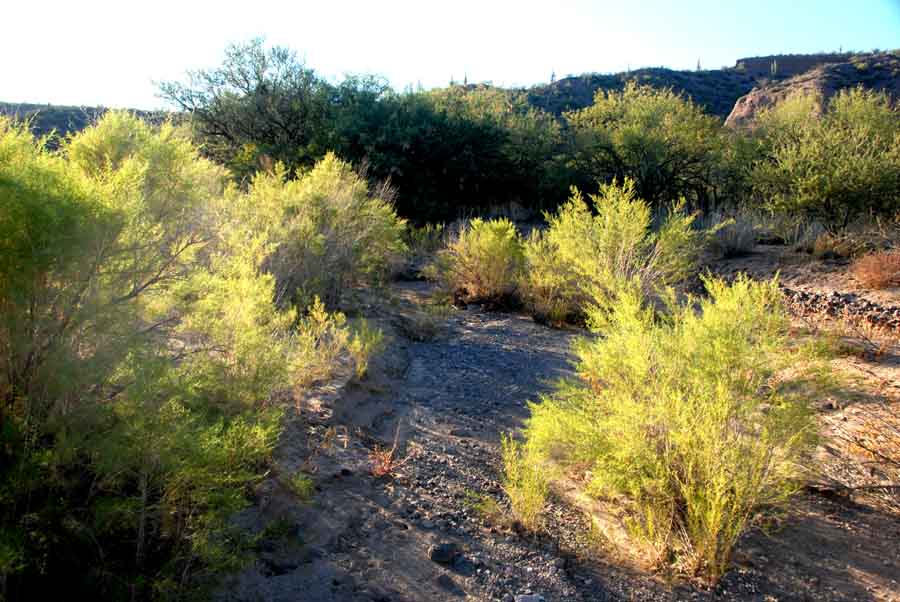
Burro Brush (Hymenoclea monogyra)
Main sources: Kearney, Thomas & Robert Peebles, et al, 1960, Arizona Flora, pp. 397-99, Berkeley: University of California Press; Shreve, Forrest, 1951, Vegetation of the Sonoran Desert, Washington, D.C.: Carnegie Institute of Washington Publication 591;
Below, two views of a Hymenoclea riparian gallery at about the same location in Lower Hot Springs Canyon, the first taken in September 2002 and the second in January 2003.
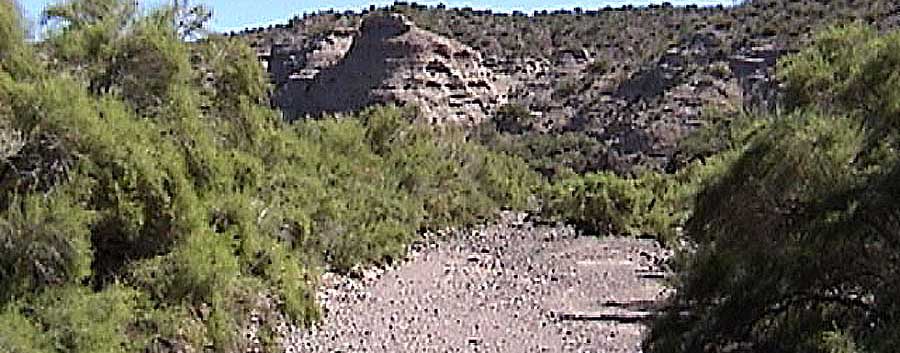

Hymenoclea is a multi-branched, erect or spreading shrub with very narrow, linear leaves. According to Forrest Shreve (cited above, page 71), "The dominant plants of the sandy flood plains throughout the Arizona Uplands are Hymenoclea monogyra and Baccharis sarothroides[Desert Broom], both of which are shrubs of rapid growth and of such habit that partial burial by sand does not interfere with their growth." [emphases provided] In our area, Hymenoclea is most prominent in our largest streamway, Hot Springs Canyon Wash, where periodic flooding over a rather wide floodplain produces frequent and substantial deposits of gravel and sand. Where sand reaches depths of three feet or more, water infiltration is rapid and the quick drying of surface sands retards water loss, enabling these plants to become established quickly after flash floods. Hymenoclea then tends to catch silt in subsequent floodings, contributes to the building of new terraces, and eventually it may form thickets along the margins of the new washes. Under favorable conditions, it may reach 12 feet in height.
In Hot Springs Canyon, a major flood in January 1993 scoured a large, central portion of the floodplain, and since that time we have been able to document the subsequent re-vegetation process. The following images and text document the changes: (click on each image to enlarge it)
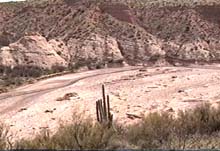 Left: The January 1991 and '93 floods greatly scoured the terraces of Hot Springs Canyon near the Rabbit Ears Saguaro Hill (from which this March 1993 photo was taken -- wash flow direction is from left to right). A new Terrace edge (with mesquites growing on the surface near it) may be seen at low-to-middle at left, marking the limits of the scour. Nearly all vegetation to the right of this has been removed by the flood (with scattered vegetable debris lying on the scoured surface in the right-hand side of the photo -- one large log carried from far upstream may be seen lying in the lower middle part of the photo).
Left: The January 1991 and '93 floods greatly scoured the terraces of Hot Springs Canyon near the Rabbit Ears Saguaro Hill (from which this March 1993 photo was taken -- wash flow direction is from left to right). A new Terrace edge (with mesquites growing on the surface near it) may be seen at low-to-middle at left, marking the limits of the scour. Nearly all vegetation to the right of this has been removed by the flood (with scattered vegetable debris lying on the scoured surface in the right-hand side of the photo -- one large log carried from far upstream may be seen lying in the lower middle part of the photo).
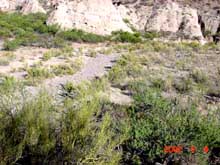 Left: This photo, taken in May 2002 from a position somewhat lower on the hill than the photo above it, shows roughly the same position of the left-bank terrace with its mesquites (though the edge has been greatly softened with time). But the main channel of the wash has become somewhat divided, and is edged by 3 distinct lines of Hymenoclea (predominantly). The new terrace being built up in the middle-right part of the picture is almost entirely vegetated with stands of Hymenoclea.
Left: This photo, taken in May 2002 from a position somewhat lower on the hill than the photo above it, shows roughly the same position of the left-bank terrace with its mesquites (though the edge has been greatly softened with time). But the main channel of the wash has become somewhat divided, and is edged by 3 distinct lines of Hymenoclea (predominantly). The new terrace being built up in the middle-right part of the picture is almost entirely vegetated with stands of Hymenoclea.
Below: down on the floodplain, you can see here the almost 10-year difference from two similar positions on the right-bank terrace (standing at the older terrace edge which the flood did not reach). Again, nearly all the new vegetation in the middle part of the right-hand picture (May 2002) is Hymenoclea. (click on each image to enlarge it)
For more images of post-flood (1993) spreading of Hymenoclea in Hot Springs Canyon, see HSC-Rabbit Ears Photos. (And, of course, our banner photos at the top of the page show its growth entirely since 1993 at this location.)
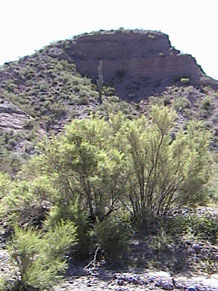
At Left, at the location in the Canyon shown in the photo pair and the top of this page, where the Hymenoclea forms a dense gallery on each side, some of the shrubs standing along the new terrace reach heights of more than 12 feet
At left, a view of Hymenoclea foliage:
At left, Hymenoclea in full flower near the Windmill, late October 2002. These flowers are quite sweetly fragrant and draw lots of bees.
In mid-November 2006, masses of the ripe seeds create a brilliant glow in late afternoon sun:
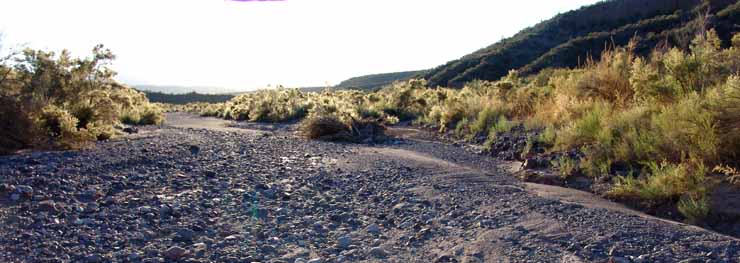
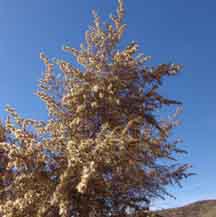 In January 2006, hymenoclea flowers had dried out during the winter drought, looking like this (at right):
In January 2006, hymenoclea flowers had dried out during the winter drought, looking like this (at right):
The flowers have dried on the stalks, but the weather had been unseasonally mild.
Hymenoclea appears to serve a valuable role in containing flood debris, accumulating silt and other deposits around its bushy base, and channeling the flow of moderate flood waters in such a way as to build up fertile terraces in floodplains. In the cold of winter it takes on a beige appearance, revealing the density of its many vertical shoots as seen below in February 2004: (click on the image for a close-up)
